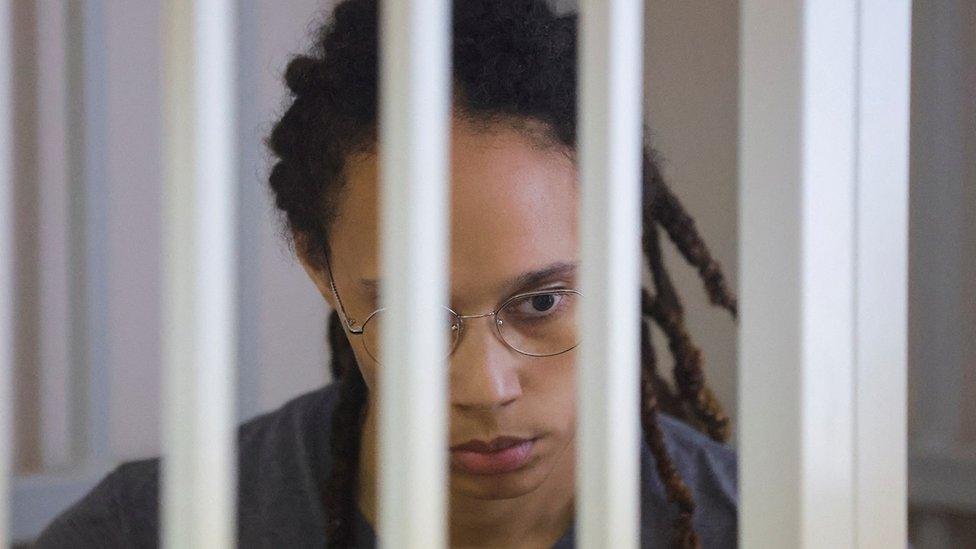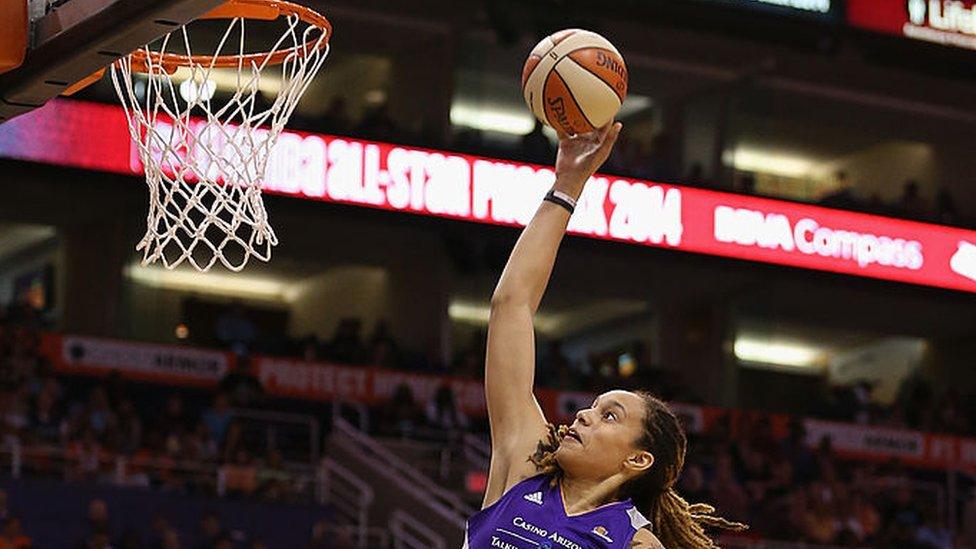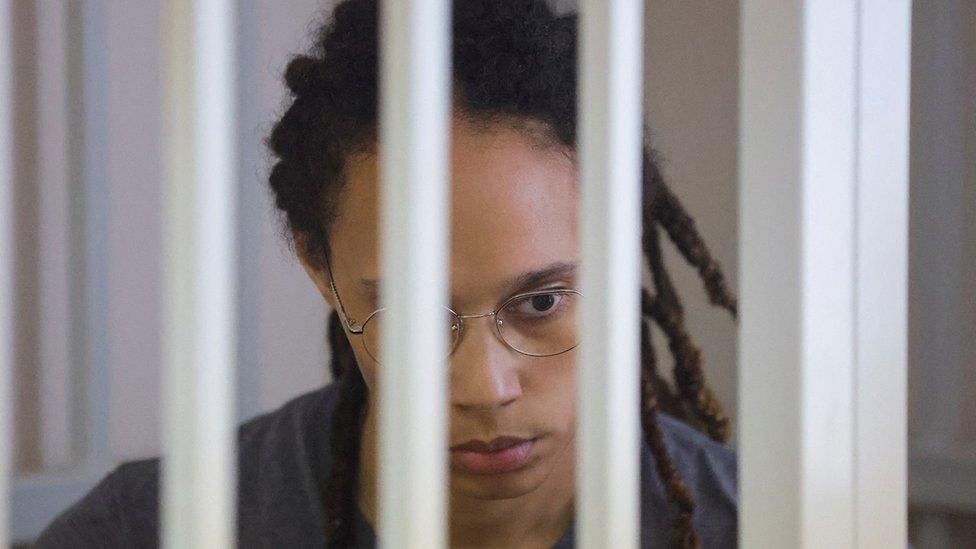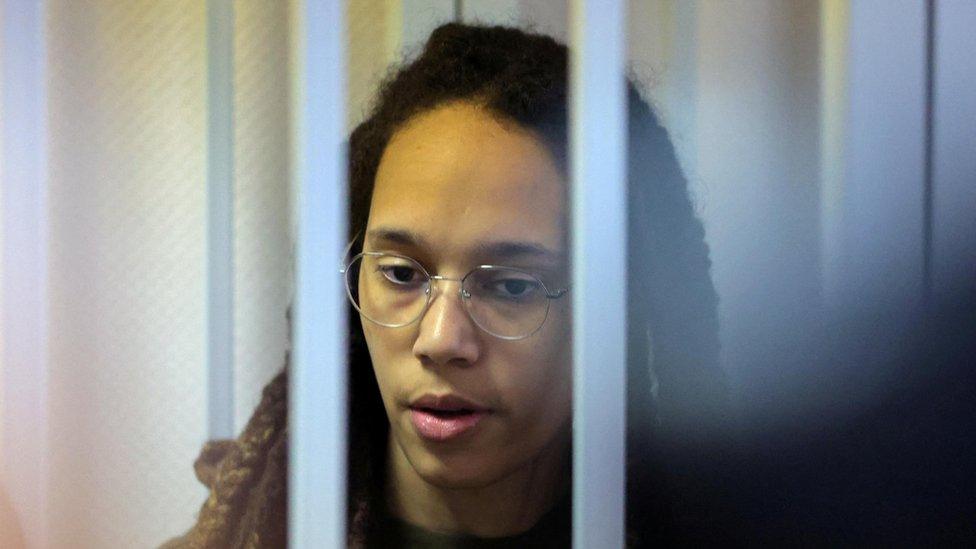What awaits Brittney Griner in Russian penal colony?
- Published

Brittney Griner was sentenced to nine years in a penal colony by a court in Russia in August
US basketball player Brittney Griner has been sent to a Russian penal colony in a remote region south-east of Moscow to serve a nine-year jail term for illegal drug possession. She joins tens of thousands of Russian women behind bars - and no-one knows how long she will serve, as the US is keen to organise a prisoner-swap to release her.
Until that happens, her life inside a Russian jail will certainly not be easy, and she will likely endure conditions as regular as any other inmate.
Griner lost her appeal against her drug conviction in early November and was then moved out of a Moscow detention centre to a penal colony. But it is only now that we have an idea where she is. Her lawyers confirmed she is being held in IK-2 women's penal colony in the remote village of Yavas in Mordovia, 500km (310 miles) south-east of the capital.
She is, the lawyers said in a statement, "doing as well as could be expected and trying to stay strong as she adapts to a new environment".
The phrase penal colony revives memories of the deadly Gulag of the Soviet era, but in this case it simply refers to a prison - with several rows of low-rise buildings housing communal barracks for inmates and separate structures housing workshops for inmates.
For days no-one, including her lawyers, knew where Griner had been sent. For Russia this is normal, and when inmates' families cannot afford a good lawyer it can sometimes take weeks for a letter to arrive from the jail.

The women's penal colony in Yavas has a capacity of 820 places (file pic)
Her jail is one of Russia's regular prison colonies, where most of 453,000 inmates are held.
Repeat offenders or those with sentences for grave crimes are sent to strict-regime or special-regime colonies. The difference lies in the number of visits allowed by relatives, the frequency of permitted parcels with food or clothing and the severity of punishments for breaking regulations.
Some grave crimes are punishable with time in cells and no access to open air at all. On the other end of the penitentiary scale are "colonies-settlements" for those committing lesser crimes. Those are more relaxed and even allow days away from the barracks.
Women make up around 5% of Russia's prison population, so there are far fewer correctional facilities for women which means relatives who want to visit have to travel further.
Griner's conviction will be of no surprise to anyone there: 13.5% of all sentences in 2021 were handed down for possession, smuggling or dealing illicit drugs. For women that number rises to 42%, although not all were custodial.
Russian police have for years been accused of beefing up crime statistics by planting drugs or pressuring detainees into confessions. This was not Griner's case: she admitted to having vape cartridges with cannabis oil in her baggage on her return to Russia in February to play club basketball during the US off-season.
She may be a women's NBA champion and Olympic gold medallist, but she does not speak Russian and there are no correctional facilities for foreigners. There are, however, 20 prisons that house various law enforcement employees who break the law, so they don't mix potentially with the criminals they helped put away.
For male prisoners, violence is an ever-present threat, either from other inmates or staff. Video recordings of torture, rape and humiliation emerged last year, providing hard evidence of an organised system of intimidation, extortion and extracting confessions, carried out by inmates egged on by prison authorities.
That kind of violence does not take place in women's prisons, but Olga Podoplelova of the NGO "Russia behind Bars" says life for inmates is not easy: "There's no established informal jail hierarchy in women's jails, but administration controls everything and there's plenty of ways of turning an inmate's life into hell."

Poor equipment means at 6ft 9in Griner will likely have to crouch at sewing machines when carrying out work
Under Russian law, inmates have to work. Most do, as refusing normally means trouble, but the highest caste of convicts in the male criminal hierarchy - known as "blatnye" - refuse on principle.
The prison regime involves meagre pay for conditions that many observers call slave labour.
"Inmates work from 12 to 16 hours a day with lunch and toilet breaks," says Ms Podoplelova. "Daily quotas are set very high, but one official salary is normally shared by several inmates. As a result, inmate workers only get a pay of several hundred roubles a month."
That is the equivalent of just a few dollars or pounds a month - a fraction of what even the poorest Russians get paid for the maximum 40-hour working week under Russian law.
While men in penal colonies often work with wood processing or welding, female inmates are invariably employed at sewing clothes, mostly uniforms for the prison service, the army or the police.
Equipment is old and workplaces poorly equipped, so Griner, who is 2.06m (6ft 9in) tall, will have to crouch at the sewing machine.
The Yavas penal colony - where Griner is thought to be imprisoned - does not have a good reputation, with inmates who worked there speaking of beatings and intimidation. "I worked as a seamstress and there is a law: if you do not fulfil the production rate, you are beaten," former inmate Irina Noskova told Russia's New Times in 2013.
Attempts to fight for inmate workers' rights are rare.
Two women who did highlight the issue with a hunger strike were Maria Alekhina and Nadezhda Tolokonnikova, jailed for two years after their Pussy Riot group staged a punk performance in a Moscow cathedral in 2012.
Alekhina served her time in two regular prisons and says traditions set back in the days of Joseph Stalin's Gulag system are well alive. "All of that [labour] is without normal food, without normal medical system and without any human rights defence," she told Reuters news agency recently.

Russian opposition leader Alexei Navalny is also serving a nine-year sentence
Tolokonnikova served part of her sentence in another women's penal colony just outside Yavas.
Russia's highest-profile prisoner is opposition politician Alexei Navalny, and he too has taken up the fight for better jail conditions and pay.
Currently serving a nine-year term in a strict-regime colony 250km (155 miles) east of Moscow, he was moved during the summer to the IK-6 penal colony which his lawyer has described as a "monstrous place". Before he was transferred to IK-6 he was jailed in Pokrov, closer to the capital.

The strict IK-6 penal colony where Russian opposition leader Alexei Navalny is being held
Navalny has proved an irritant for the prison system. He too was made to sew clothing but managed to convince the authorities to replace old short four-legged stools with proper swivel chairs for him and a few co-workers.
In August he announced the creation of an inmate workers' trade union but so far no other inmate has dared to join. He has since been given repeated spells in solitary confinement, for transgressions such as wearing his robe unbuttoned, or for not keeping his hands behind his back while walking past a warden.
His conditions were further tightened in November, when his allies said he was moved to a "covered cell block", without access to open air. On his Telegram messaging account he described his cell as "very small... like the one in solitary confinement".
The prison has made communicating with his defence lawyers hard. A glass screen that separated them was replaced with an opaque film and then they were barred from showing him documents. "I am put in a 1m x 1m room, facing a wall of plastic with human contours behind it," he complained.
Brittney Griner is very unlikely to face this kind of pressure. But there is little chance her foreign passport and sporting fame will buy her any relief from conditions endured by ordinary inmates.
Another inmate whom US officials are eager to see released is ex-marine Paul Whelan, jailed in 2020 for alleged spying. Like Navalny he has faced solitary confinement, and like Griner he is being held in a penal colony in Mordovia, just a short drive away.
- Published9 November 2022

- Published26 October 2022

- Published22 December 2020
